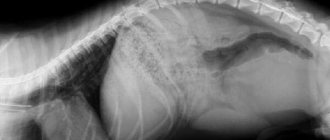Many people are familiar with such a complex and dangerous disease as diabetes. However, not everyone knows that this disease can also affect dogs. This endocrine disease, caused by a malfunction of the metabolic processes occurring in the animal’s body, is a complex pathology that can be very dangerous in the absence of the necessary medical care.
Diabetes mellitus is quite common in dogs. The approach to treating this complex, dangerous disease must be very serious and responsible. Diabetes is a difficult and incurable disease, but with timely treatment it is not fatal. With the right approach, the owner can help his pet cope with this disease and significantly improve his quality of life.
What increases your risk of diabetes?
The medical classification of types of diabetes mellitus cannot be applied to dogs. In dogs of genetically predisposed breeds, signs of the disease appear at any age. Acquired diabetes develops in unspayed female dogs over 7 years of age.
The following factors predispose to the occurrence of the disease:
- obesity;
- chronic diseases of the liver, pancreas;
- history of imaginary pregnancy;
- uncontrolled use of hormonal contraceptives;
- failures due to abuse of steroidal anti-inflammatory drugs.
Overfeeding in combination with physical inactivity contributes to the development of diabetes.
Your dog is losing weight despite eating normally
Many diseases can cause weight loss in dogs, including cancer, gastrointestinal disease, and liver and kidney disease.
When this weight loss, which can begin gradually or suddenly, is combined with a normal appetite, it may be a sign of diabetes.
Because insulin doesn't work to deliver glucose to the brain, heart, and other organs needed to produce energy, the body begins to break down muscle and fat to use those proteins and fat instead, resulting in weight loss.
What causes diabetes in a dog: causes
The most common cause of diabetes is the inability of tissues to absorb glucose. The hormone insulin is responsible for the penetration of the monosaccharide into the cell. Diabetes develops under the influence of the unfavorable factors mentioned above. The tissues are starved, glucose is not digested.
It accumulates in the blood. The body perceives hyperglycemia as a life-threatening condition and takes measures to eliminate the toxic substance in the urine. The animal drinks a lot, urinates often, but the rate of removal of sugar from the blood does not keep pace with its accumulation.
In rare cases, diabetes is not caused by insulin tolerance, but by the inability of the pancreas to produce the hormone in required quantities. The pathological condition develops with pancreatitis.
Your dog seems stiff or weaker than usual
Your dog may stumble, become stiff, or have difficulty lying down. Dogs with diabetes may develop muscle weakness due to a lack of glucose entering their muscles.
Another less common cause is diabetic neuropathy, which can lead to chronic or progressive hind limb weakness, joint weakness, muscle wasting and general weakness.
Although not as common, a dog with diabetes may develop drooping hocks, a condition in which the hind legs are closer to the ground than they should be. Owners may notice that the dog is standing or walking strangely.”
What breeds are at risk?
Doberman Pinschers, exotic, toy and small breeds of dogs are predisposed to diabetes:
- Labrador Retriever;
- beagle;
- pug, poodle;
- dachshund;
- spaniel;
- Pomeranian Spitz;
- Scotch Terrier.
Owners of these dog breeds need to monitor the weight of the animal and conduct blood tests for sugar levels at intervals determined by the veterinarian.
Your dog's vision is deteriorating
Dogs with diabetes are at increased risk of blindness as a result of cataract formation.
Cataracts, which completely block light from reaching the retina at the back of the eye, cause vision loss.
The good news is that as long as any secondary inflammation caused by the cataract is controlled, most blind dogs do well because they have excellent senses of smell and hearing and are adaptable to their environment.
In some cases, blindness can be reversed by surgically removing the abnormal lens.
Blindness (and cataract formation) can last from weeks to months or in as little as 24 hours. This can also happen in early or late stage diabetes.
Signs and symptoms of diabetes in dogs
If a dog walks on the lawn or in the garden, ants accumulate where he relieves himself because the urine is sweet.
Other symptoms of diabetes:
- Insatiable thirst: the dog drinks constantly to dilute the concentration of glucose in the blood.
- Frequent and copious emptying of the bladder.
- The animal develops an appetite due to the fact that the tissues are starving.
- An initially obese pet quickly loses weight because food is not digested.
- The gait becomes unsteady, the animal weakens.
- Due to overload, the bladder becomes inflamed and emptying becomes painful.
- Starving tissues die: erosions and ulcers appear on the skin, microflora join in, and pyoderma develops.
- Vision weakens, the lens becomes cloudy.
- The body turns on mechanisms that lower blood glucose levels. Hypoglycemia develops, which is characterized by convulsions, loss of consciousness, and falling into a diabetic coma.
When the body begins to extract glucose from fat and muscle tissue, a serious condition develops - ketoacidosis.
The smell of acetone comes from the mouth, the skin smells unpleasantly of a dog. Toxins accumulate in the blood and the body removes them through vomiting and diarrhea. The pet lies down, and when it gets up, shortness of breath occurs.
The body temperature drops, the stench from the skin attracts flies, their appearance signals approaching death.
Symptoms
Pathology can be suspected based on the following signs:
- polydipsia (increased thirst);
- frequent salivation, the consistency of saliva is sticky and viscous;
- polyuria (increased urination), while the dog goes to the toilet often, but urine is released in large quantities;
- polyphagia (gluttony), which is characterized by eating the usual portions with great speed;
- weight deficiency to the point of exhaustion - the dog’s ribs are clearly visible, the stomach falls in;
- cardiopalmus;
- unpleasant sour odor from the mouth;
- dull, tousled coat, alopecia;
- cataract;
- dry skin, skin diseases;
- enlarged liver;
- poor blood clotting and slow wound healing;
- vomiting, diarrhea (in rare cases).
The dog's behavior also changes. She becomes lethargic, apathetic, moves little and shows no interest in walks. If the dog is a street dog, then it is much more difficult to notice his characteristic signs, except that painful thinness immediately catches the eye.
Diagnostics, blood sugar levels in a dog
The cause of the disease is identified during a clinical examination. They collect anamnesis - interview the patient about the pet’s behavior, its age, living conditions, and diet. If diabetes is suspected, the veterinarian will prescribe a general analysis and biochemical blood tests. A glucose test is informative.
A sugar concentration of 4.0 to 7.0 mmol/l is taken as the norm.
A short-term excess of the limit occurs after eating. When the glucose level exceeds 11 mmol/l, the preliminary diagnosis is confirmed - the dog has diabetes mellitus.
A drop below normal occurs at the final stage of the disease or with uncontrolled use of glucose-lowering drugs. The animal may lose consciousness and fall into a coma.
The condition of the pancreas is assessed by ultrasound, cardiac activity by ECG.
Treatment method and prognosis
The principle of treating diabetes mellitus is to stabilize the general condition, eliminate symptoms and, most importantly, bring glucose to normal levels (no more than 8-10 mmol/l).
Normalization of glycemic metabolism is carried out with the help of insulin injections, as well as the management of primary and secondary pathologies. It is impossible to completely cure diabetes, so you will have to monitor your blood sugar levels and prevent them from rising in the blood throughout the life of your pet.
Important: for type 1 diabetes mellitus, so-called short-acting insulin is used, for type 2 diabetes, long- or medium-acting insulin is used. When insulin is administered, glucose is brought to a level above the upper normal limit. This measure is due to a reduction in the risk of hypoglycemia - a sharp drop in sugar.
The drug is administered using special injection pens or insulin syringes. The dosage of the medicine is prescribed by the veterinarian based on the condition of the dog. At first it is minimal (0.5 units/kg body weight), then it can gradually increase. To select the dosage, the doctor will need to observe the dog’s condition for several days, and sometimes even months.
Convenient places for insulin administration are the abdomen, chest, and withers. Use your fingers to form a fold of skin, after which a needle is carefully inserted into its base.
The specialist monitors the dynamics of changes in glucose levels, usually using blood tests (every 2-4 hours) as the most convenient method. The veterinarian also evaluates the dog’s general health and behavior: frequency of urination, weight gain, increased appetite. If the dosage of insulin is selected correctly, then the main signs of diabetes disappear.
It is very important to remember that too much insulin is just as dangerous for a dog as too little. So, if the owner does not remember whether he administered the drug or not, it is better not to risk it and skip one injection. Otherwise, the dog may develop Somogyi syndrome, which poses a danger to the patient’s life.
If the doctor's instructions are strictly followed and insulin is administered strictly according to the schedule, you can expect that the dog will live a long and full life. However, from the moment diabetes is diagnosed, the veterinarian becomes a constant consultant and observer of the animal’s well-being.
Treatment of diabetes in dogs
Sugar disease is treated with conservative and surgical methods.
The therapeutic strategy is developing in the following directions:
- Symptomatic treatment at the discretion of the veterinarian.
- Using insulin to maintain glucose concentrations between 6 and 18 mmol/L. The initial dosage is determined by the doctor. He shows the dog owner how to administer insulin and test blood sugar levels. The dog breeder records the results of measurements for a week. The doctor studies the indicators and adjusts the dose.
- Diet therapy - with the help of veterinary ready-made feeds, average nutritional status is achieved and maintained.
- The use of drugs that reduce the side effects of glucose-lowering medications.
- Determination of physical activity that allows you to maintain average fatness and does not cause a deterioration in the pet’s well-being.
Watch the video:
When conservative therapy does not bring the expected results, the sick bitch begins lactation or estrus, and the animal is castrated. The operation leads to a complete recovery. But before surgery, they find out whether there are any contraindications, whether the animal can withstand anesthesia?
Side effects of insulin
A typical side effect of insulin administration is hypoglycemia (an abnormal drop in glucose levels). Its typical signs are convulsions, general weakness, a state of stagnation and coma. Hypoglycemia is a dangerous acute condition that requires immediate administration of glucose to the animal. To do this, you can inject the drug intramuscularly or give the dog a piece of sugar. If this side effect develops, insulin injections are not given for some time, after which the drug is resumed, but in a lower dosage.
Another side effect is Somogyi syndrome, a physiological phenomenon consisting of the animal’s body reacting to a sharp decrease in glucose levels. This syndrome can develop when the animal is given too high doses of medication. They first cause a sudden drop in glucose levels, and then an uncontrolled release of diabetogenic hormones into the animal’s blood. This leads to the development of hypoglycemia in the animal, which usually goes unnoticed by the owner. Only a specialist can save a dog from the consequences of chronic insulin overdose.
Nutrition for diabetes in dogs
During treatment, the pet is transferred to veterinary nutrition with ready-made food for dogs with diabetes.
Followers of natural food should exclude the following products from their diet:
- fried, sweet, salty, smoked dishes;
- confectionery;
- sweets, candies, chocolate;
- store-bought treats.
A diet of natural products will be agreed upon with a veterinarian.
Why are glucose and insulin needed?
In order for the body to convert nutrients into energy, two things are needed: glucose and insulin.
Glucose is the body's fuel. The body receives glucose when it breaks down nutrients. This type of sugar is a source of energy for the organs and cells of the body. From the gastrointestinal tract, glucose enters the blood, and the blood carries glucose throughout the body.
Insulin is produced by the pancreas. This hormone is responsible for ensuring that glucose enters cells and organs. Insulin tells cells to take up glucose and other nutrients.
Insulin is the key that opens the glucose channel. Through this channel, glucose enters the cell and nourishes it.
Caring for a sick dog
If surgery is contraindicated for a dog, it will require lifelong care. The owner injects insulin daily, within a time frame agreed upon with the veterinarian, takes the animal for a walk, and ensures that physical activity is moderate.
When insulin does not get under the skin, the injection should not be repeated, otherwise hypoglycemia will develop. A dog showing signs of ketoacidosis should be hospitalized immediately.
Your dog's eyes look cloudy
Up to 80% of dogs with diabetes will eventually develop some degree of cataracts. Cataracts are one of the most common long-term complications in dogs with diabetes.
In a healthy dog, she says, the lens absorbs glucose from the eye fluid and converts the excess into sorbitol.
When there is a large amount of glucose, a large amount of sorbitol is formed. Sorbitol strongly attracts water, so water gets into the lens and causes the fibers to distort, preventing light from passing through.
This can make your dog's eyes appear cloudy.
How to prevent diabetes in dogs: prevention?
Veterinarians recommend the following measures to prevent diabetes:
- overweight animals are switched to a diet for weight correction;
- provide daily walking with moderate physical activity;
- bitches who have reached the age of seven, as well as females in whom repeated false pregnancy is detected, are castrated.
Pedigree animals whose puppies are found to have diabetes are excluded from breeding.
Early intervention matters
Learning to recognize the signs of diabetes in dogs and communicate with your veterinarian will help you intervene early.
Diabetes in dogs is usually a manageable disease; most dogs with diabetes can do very well with an insulin regimen.
It's important to note that while diabetes is not as common in puppies as it is in older dogs, it can still occur.
Be sure to consult your veterinarian if you notice anything unusual, whether in your older dog or puppy.
International Veterinary Center for Reproduction and Artificial Insemination of Small Animals
| DIABETES IN DOGS Perepechaev Konstantin Andreevich veterinary ophthalmologist, microsurgeon, Ph.D. 07.12.2012 |
1. INTRODUCTION
Diabetes mellitus (diabetes mellitus) is a chronic endocrine metabolic disease caused by an absolute or relative deficiency of the hormone insulin. The disease develops as a result of the combined influence of various endogenous (genetic) and exogenous (external) factors, and is characterized by metabolic disorders with its most constant manifestation - hyperglycemia, the development of damage to blood vessels, nerves, various organs and tissues. A demonstrative and obligatory manifestation of the disease is a violation of carbohydrate metabolism with a progressive increase in the level of glucose in the blood and its excretion in the urine. Significant losses of sugar in the urine cause persistent osmotic diuresis (diabetes) and developing dehydration and potassium loss.
2. DIABETES IN DOGS
Diabetes mellitus in dogs occurs in 95% of cases in unsterilized female dogs aged 7-8 years and older. The exact cause of the disease has not been established to date; hereditary predisposition, hormonal disorders, and severe infectious and systemic diseases are considered as predisposing factors. The main clinical signs to suspect diabetes mellitus in dogs are: increased thirst and frequent excessive urination (polyuria and polydipsia), lethargy, and thinness. Owners often note that the urine has become sticky (due to its high glucose content). The diagnosis is made after measuring blood glucose levels. When the level of glucose in venous blood is above 11 mmol/l, a diagnosis of diabetes mellitus is made.
3. REASONS FOR FAILED TREATMENT OF DIABETES IN DOGS
Unfortunately, a huge number of dogs die due to improper and inadequate treatment of this disease. In our opinion, the reasons for this are:
- Lack of awareness among veterinarians about modern methods and basic principles of control and treatment of diabetes.
- The attending physician lacks real practical experience in using various types of insulins, working with glucometers, insulin syringes and syringe pens.
- The attending physician lacks practical experience in the correction of life-threatening hyper and hypoglycemia, as well as in the management of diabetic patients during complex operations, including ophthalmological and abdominal operations, treatment of oncological and infectious diseases associated with diabetes.
- Reluctance of owners to observe the basic principles of diabetes treatment in relation to a sick animal, similar to those accepted in humane medicine (regular and daily self-measurement of blood glucose levels and administration of precise doses of insulin).
4. MYTHS RELATED TO DIABETES
Today, regarding the treatment of diabetes in dogs, there are a huge number of MYTHS that not only interfere with the effective and safe treatment of diabetes, but in many cases simply destroy the animals.
MYTH 1. Treating diabetes is useless, it is torture for the animal and the dog will die anyway.
Treatment of diabetes in dogs is well established, safe, and even more effective than in humans. The only thing that is required from the owner is to learn how to measure glucose and administer insulin twice a day. These procedures are easy to perform and absolutely painless. The life expectancy of dogs with diabetes even EXCEEDS the life expectancy of normal, healthy dogs, largely due to daily metabolic control, proper nutrition and care.
MYTH 2. Insulin is a dangerous and toxic drug; it cures one thing and cripples another. Insulin is poorly tolerated by dogs and is ineffective.
Modern genetically engineered insulins are absolutely safe, highly effective, well tolerated and only affect glucose levels. Insulin can be administered to even young, very old, and even pregnant or lactating dogs. We have been using modern insulins to treat diabetes in dogs for more than 10 years; during this time, not a single adverse reaction to the administration of the drug has been noted.
MYTH 3. It is difficult for a dog to draw blood to measure glucose levels and human glucose meters and needles (lancets) are not suitable for this.
The technology for taking blood from dogs is well established, absolutely painless and easy to perform. Modern medical glucose meters and lancets are IDEAL for daily glucose monitoring in dogs.
MYTH 4. To monitor glucose levels, blood can be taken periodically - 1-2 times a month, and insulin can be administered approximately according to the dog’s condition (a little more - a little less).
This is absolutely ignorant and extremely dangerous! Only based on DAILY double glucose measurements, the insulin level for EVERY injection is accurately selected. “Approximate” selection of the insulin dose leads either to undercorrection of glucose levels (constant hyperglycemia), which nullifies the meaning of diabetes treatment, or to the development of hypoglycemia, coma and death.
MYTH 5. My dog always has high (above 15-20 mmol/l) glucose levels and feels great. This means everything is fine and there is no need to do anything else, why lower the glucose level further?
The pathological process associated with elevated glucose levels stops only when the glucose level remains within the normal range of 4.5 -7.5 mmol/l. If the glucose level is undercorrected, despite the administration of insulin, the process of damage to the vascular and nervous system continues, although unnoticed by the owner. The concept of diabetes treatment is to correct glucose levels as completely as possible, rather than partially.
MYTH 6. No matter how much insulin we use, our glucose levels still do not return to normal. The doctor said that this is normal and nothing can be done. That's how we live…
Your doctor simply does not know how to work with insulins and does not know the principles of dose selection. In 100% of cases out of 100, any patient CAN and SHOULD bring the glucose level back to normal.
MYTH 7. We try to use the smallest dose of insulin possible and try to correct glucose levels with glucose-lowering pills, nutrition and exercise.
It is pointless. Diabetes mellitus in dogs is always insulin dependent (similar to Type 1 in humans). Insulin is an absolutely safe drug; it can and should be administered as much as necessary, since it does not affect anything other than glucose. It is impossible to correct a dog’s glucose level with tablets, nutrition and exercise.
MYTH 8. To treat diabetes in dogs, only special veterinary (canine) insulin can be used. It is difficult to obtain, expensive and only sold in veterinary pharmacies or veterinarians.
There is no “special veterinary” insulin in nature. What is called “veterinary” is regular PORK insulin, which was used to treat people decades ago. Modern human genetically engineered insulins are PERFECTLY suitable for treating dogs. They are superior in quality and controllability of action to “veterinary” insulin, are sold in regular pharmacies and are cheaper.
MYTH 9. Our dog has been diagnosed with diabetes. But the doctor said that first, we will treat the general condition (correction of the liver and kidneys, etc.), select a special diet, the dog will feel better, and only then we will begin to treat diabetes mellitus...
It is not right. Treatment of diabetes mellitus should be started IMMEDIATELY and IMMEDIATELY administer insulin, monitor glucose levels and adjust the dose. Stabilization of the general condition is carried out in parallel with the treatment of diabetes mellitus or after normalization of glucose levels.
MYTH 10. Our dog began to develop cataracts due to diabetes. The dog is going blind. The doctor said that nothing can be done, accept it...
This is ignorant and cruel. Diabetic cataracts are PERFECTLY treated with surgery. After cataract removal and artificial lens implantation, your dog will have excellent vision for the rest of his life. The success rate of cataract surgery in diabetic dogs is even higher than in normal cataract patients and is 98-99%. There are only two points to consider:
- Diabetic cataracts must be operated on AS EARLY AS POSSIBLE - no later than 1-2 months after a decrease in visual function. Otherwise, the destruction of the clouded lens will lead to the development of an inflammatory process and death of the retina and the eyeball itself.
- Correction of diabetes and selection of insulin dosage should be carried out by the doctor (clinic) where the cataract surgery will be performed. Only they can take into account and predict fluctuations in glucose levels in the postoperative period and adjust the insulin dose.
MYTH 11. Our dog has developed diabetes. She is not sterilized. Doctors say that she needs to be sterilized, but we are very afraid of the operation. They say that there may be serious complications, it will heal poorly, etc...
A dog with diabetes should be sterilized as early as possible and without fail. Against the background of hormonal changes during the period of estrus, the level of glucose in the blood will change sharply and spasmodically. Many dogs with diabetes die from hypoglycemic coma during estrus. Neutering your dog is the FIRST thing you should do after insulin has stabilized your blood glucose levels. There will be no complications or operational problems when the dog’s blood glucose level is controlled. Moreover, in our practice, we often perform cataract surgery on diabetic dogs at the same time as neutering.
MYTH 12. If your dog is treated correctly, he should make a full recovery and you won’t have to do anything else, or at least you won’t need to measure your sugar levels or inject insulin.
Diabetes mellitus cannot be cured; the animal will never be able to produce its own insulin and regulate its sugar levels on its own. Treatment of diabetes is lifelong and consists of constant and regular (daily) measurement of blood glucose levels and administration of insulin. Only under this condition can the dog live a comfortable, long and fulfilling life. If insulin is withdrawn, the animal will inevitably die.
MYTH 13. If a dog with diabetes is given insulin, it will become disabled. She will never be so joyful and playful again; she will eat poorly, sleep a lot, be lethargic, sick and disabled.
This is not true; modern drugs to lower sugar levels (insulins) allow a person or animal with diabetes to lead an absolutely normal and fulfilling life. The only thing you need to do is measure your glucose level 2 times a day and inject insulin. With stable glucose levels, your dog will delight you for many years with its temperament, physical activity and vitality. Minimum restrictions and maximum freedom is the motto of modern diabetic patients, both two-legged and four-legged.
5. OUR APPROACH TO TREATING DIABETES IN DOGS
Our center has been treating diabetes mellitus in dogs for more than 10 years. Initially, this was due to the need to perform complex ophthalmological operations (phacoemulsification of cataracts with implantation of an artificial lens) in patients with diabetes. Over the course of 10 years, not only has the technique of monitoring glucose levels and the use of insulin been developed, but also enormous theoretical and practical experience has been accumulated in performing complex abdominal operations on diabetic dogs, treating infectious and oncological diseases, as well as correcting life-threatening hyper and hypoglycemia. Treatment of diabetes mellitus in dogs in our center consists of several important stages:
Stage 1:
Initial examination of a patient with diabetes, laboratory confirmation of the diagnosis. Comprehensive examination of a sick animal, identification of problems not related to diabetes. Ophthalmological examination. Determination of treatment tactics (Fig. 1).
Figure 1. Initial examination of a patient with diabetes.
Stage 2:
Teaching the dog owner how to draw blood to measure glucose levels; working with a glucometer. Explanation of the basic principles of insulin therapy and techniques for storing, collecting and administering insulin. Methods for monitoring glucose levels and insulin doses. What to do if your glucose level is high/low (Figure 2).
Figure 2. Theory and practice of insulin therapy...
Starting from this stage, the owner begins to independently (2 times a day) measure glucose levels and administer insulin. During the first month of self-treatment, the owner must call the attending physician 2 times a day and, with his help, adjust the doses of insulin administered. We provide patient support 24 hours a day, 7 days a week. At any time, the patient can come to our center for additional examination and correction of the condition.
Stage 3:
After the patient reaches a stable normal glucose level of 4 to 11 mmol/L (usually this period takes from 1 to 4 weeks), we perform surgical treatment of diabetic cataracts and sterilization (ovariohysterectomy) of the dog. After the operation, the patient remains in our clinic for as long as necessary for postoperative stabilization of glucose levels (Fig. 3).
Figure 3. Simultaneous removal of diabetic cataract and ovariohysterectomy (sterilization) of a dog.
Stage 4:
Mandatory preventive examinations of a patient with diabetes, once every 1-6 months, correction of insulin doses. Selection of nutrition that optimizes glucose levels. Regular diagnostic examinations (Figure 4).
Figure 4. Preventative screenings and testing are an important part of keeping a dog with diabetes healthy.
Our center constantly has all the devices, drugs and consumables necessary for the treatment of diabetes: glucometers, lancets, test strips, insulin syringes, insulins, etc. (Figure 5).
Figure 5. We have everything you need to effectively treat your pet's diabetes.
| Perepechaev Konstantin Andreevich veterinary ophthalmologist, microsurgeon, Ph.D. tel.: 8-926-523-18-97 website: https://9265231897.ru |
The authorship of this article belongs to Konstantin Andreevich Perepechaev and is protected by the Copyright Law. Any copying of materials without indicating the author and a link to the original source “International Veterinary Center for Reproduction and Artificial Insemination of Small Animals” is prohibited
Similar materials
- REMOVAL OF PARANANAL GLANDS IN DOGS
- CLINICAL CASE: UROLITHIASIS, BLADDER STONES AND URETHRAL OBSTRUCTION IN A YORKSHIRE TERRIER
- Surgical treatment of intestinal carcinoma in an elderly dog
- Brucellosis in dogs.
- Oral melanoma in a dog
What else can a veterinarian do?
In addition to the fact that the veterinarian can make the correct diagnosis, prescribing what to treat in this case, he will also help build nutrition for the dog. And this will change the way of life that was familiar to this time. The doctor will also tell you about the subtleties that cannot be ignored. And this means that you always have insulin at hand, especially on the road. Only opened packaging lasts for 1 to 2 months.
Don't be embarrassed to ask your doctor. His help will help you properly help your pet. You will learn how to store insulin itself and how to give injections. And periodic monitoring by a veterinarian will prevent you from missing something important with such a disease.











